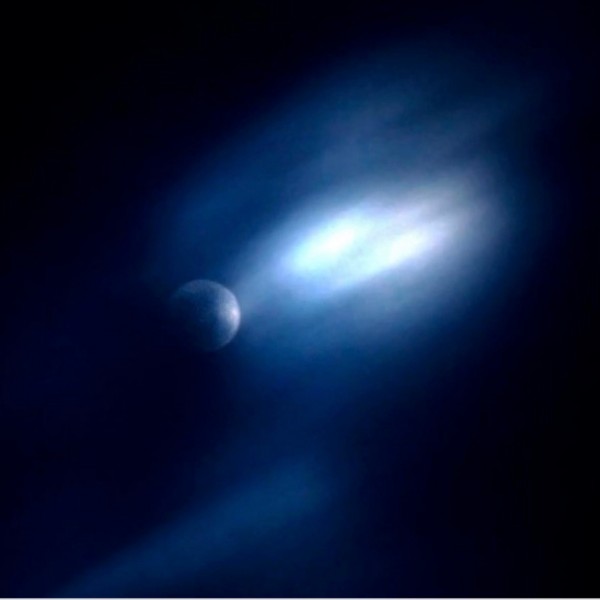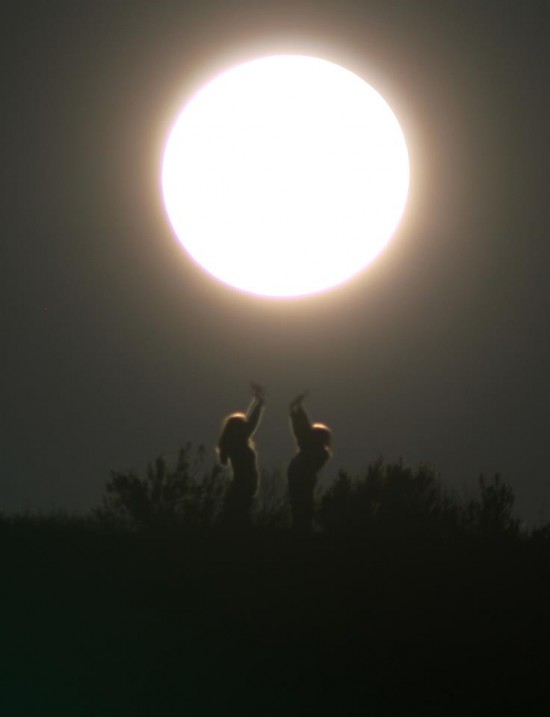

Most Blue Moons are not blue in color. This photo of a moon among fast-moving clouds was created using special filters. Image via EarthSky Facebook friend Jv Noriega.
We had a Blue Moon on January 31, 2018. It was a supermoon, too, and underwent a total eclipse photos here. But another Blue Moon is coming right up. They’re both Blue Moons by the monthly definition of the term: the second of two full moons to fall within a single calendar month. The second (and last) Blue Moon of 2018 will be on March 31. We haven’t had a year with two Blue Moons since 1999 and won’t have one again until January and March, 2037.
The expression once in a Blue Moon used to indicate something rare. But, as this year’s two Blue Moons shows, they can be pretty common.
That’s because, in recent years, people have been using the name Blue Moon for two different sorts of moons. The first can be the second of two full moons in a single calendar month, as with the March 31 Blue Moon. An older definition says a Blue Moon is the third of four full moons in a single season. Someday, you might see an actual blue-colored moon.
Meanwhile, the month of February 2018 has no full moon at all.
The Maine Farmer’s Almanac defined a Blue Moon as an extra full moon that occurred in a season. One season – winter, spring, summer, fall – typically has three full moons. If a season has four full moons, then the third full moon may be called a Blue Moon.
There was a Blue Moon by this definition on November 21, 2010, another on August 20-21, 2013, and another on May 21, 2016.
The next seasonal Blue Moon (third of four full moons in one season) will take place May 18, 2019.
Very rarely, a monthly Blue Moon (second of two full moons in one calendar month) and a seasonal Blue Moon (third of four full moons in one season) can occur in the same calendar year. But for this to happen, you need 13 full moons in one calendar year and 13 full moons in between successive December solstices.
This will next happen in the year 2048, when a monthly Blue Moon falls on January 31, and a seasonal Blue Moon on August 23.

This photo was created using special blue filters, too. Image via EarthSky Facebook friend Jv Noriega.
Using the name Blue Moon to describe the second full moon of a calendar month is now the best-known and most popular definition. By this definition, there was a Blue Moon on July 31, 2015, and then – of course – the recent one on January 31, 2018.
The time between one full moon and the next is close to the length of a calendar month. So the only time one month can have two full moons is when the first full moon happens in the first few days of the month. This happens every two to three years, so these sorts of Blue Moons come about that often.
The idea of a Blue Moon as the second full moon in a month stemmed from the March 1946 issue of Sky and Telescope magazine, which contained an article called “Once in a Blue Moon” by James Hugh Pruett. Pruett was referring to the 1937 Maine Farmer’s Almanac, but he inadvertently simplified the definition. He wrote:
Seven times in 19 years there were — and still are — 13 full moons in a year. This gives 11 months with one full moon each and one with two. This second in a month, so I interpret it, was called Blue Moon.
Had James Hugh Pruett looked at the actual date of the 1937 Blue Moon, he would have found that it had occurred August 21, 1937. Also, there were only 12 full moons in 1937. You need 13 full moons in one calendar year to have two full moons in one calendar month.
However, that fortuitous oversight gave birth to a new and perfectly understandable definition for Blue Moon.
EarthSky’s Deborah Byrd happened upon a copy of this old 1946 issue of Sky and Telescope in the stacks of the Peridier Library at the University of Texas Astronomy Department in the late 1970s. Afterward, she began using the term Blue Moon to describe the second full moon in a calendar month on the radio. Later, this definition of Blue Moon was also popularized by a book for children by Margot McLoon-Basta and Alice Sigel, called Kids’ World Almanac of Records and Facts, published in New York by World Almanac Publications in 1985. The second-full-moon-in-a-month definition was also used in the board game Trivial Pursuit.
Today, it has become part of folklore. As the folklorist Philip Hiscock wrote in his comprehensive article Folklore of the Blue Moon:
Old folklore it is not, but real folklore it is.

What most call a Blue Moon isn’t blue in color. It’s only Blue in name. This great moon photo is from EarthSky Facebook friend Rebecca Lacey in Cambridge, Idaho.
Can a moon be blue in color? Yes, but it’s very rare to see a blue-colored moon. You need unusual sky conditions – certain-sized particles of dust or smoke – to create them.
Blue-colored moons aren’t predictable. So don’t be misled by the photo above. The sorts of moons people commonly call Blue Moons aren’t usually blue.
For more about truly blue-colored moons, click here.
Enjoying EarthSky so far? Sign up for our free daily newsletter today!
Bottom line: A blue-colored moon is rare. But folklore has defined two different kinds of Blue Moons, and moons that are Blue by name have become pretty common. The next Blue Moon is March 31, 2018.
Possible to have only two full moons in one season?
from EarthSky http://ift.tt/SSlbBZ


Most Blue Moons are not blue in color. This photo of a moon among fast-moving clouds was created using special filters. Image via EarthSky Facebook friend Jv Noriega.
We had a Blue Moon on January 31, 2018. It was a supermoon, too, and underwent a total eclipse photos here. But another Blue Moon is coming right up. They’re both Blue Moons by the monthly definition of the term: the second of two full moons to fall within a single calendar month. The second (and last) Blue Moon of 2018 will be on March 31. We haven’t had a year with two Blue Moons since 1999 and won’t have one again until January and March, 2037.
The expression once in a Blue Moon used to indicate something rare. But, as this year’s two Blue Moons shows, they can be pretty common.
That’s because, in recent years, people have been using the name Blue Moon for two different sorts of moons. The first can be the second of two full moons in a single calendar month, as with the March 31 Blue Moon. An older definition says a Blue Moon is the third of four full moons in a single season. Someday, you might see an actual blue-colored moon.
Meanwhile, the month of February 2018 has no full moon at all.
The Maine Farmer’s Almanac defined a Blue Moon as an extra full moon that occurred in a season. One season – winter, spring, summer, fall – typically has three full moons. If a season has four full moons, then the third full moon may be called a Blue Moon.
There was a Blue Moon by this definition on November 21, 2010, another on August 20-21, 2013, and another on May 21, 2016.
The next seasonal Blue Moon (third of four full moons in one season) will take place May 18, 2019.
Very rarely, a monthly Blue Moon (second of two full moons in one calendar month) and a seasonal Blue Moon (third of four full moons in one season) can occur in the same calendar year. But for this to happen, you need 13 full moons in one calendar year and 13 full moons in between successive December solstices.
This will next happen in the year 2048, when a monthly Blue Moon falls on January 31, and a seasonal Blue Moon on August 23.

This photo was created using special blue filters, too. Image via EarthSky Facebook friend Jv Noriega.
Using the name Blue Moon to describe the second full moon of a calendar month is now the best-known and most popular definition. By this definition, there was a Blue Moon on July 31, 2015, and then – of course – the recent one on January 31, 2018.
The time between one full moon and the next is close to the length of a calendar month. So the only time one month can have two full moons is when the first full moon happens in the first few days of the month. This happens every two to three years, so these sorts of Blue Moons come about that often.
The idea of a Blue Moon as the second full moon in a month stemmed from the March 1946 issue of Sky and Telescope magazine, which contained an article called “Once in a Blue Moon” by James Hugh Pruett. Pruett was referring to the 1937 Maine Farmer’s Almanac, but he inadvertently simplified the definition. He wrote:
Seven times in 19 years there were — and still are — 13 full moons in a year. This gives 11 months with one full moon each and one with two. This second in a month, so I interpret it, was called Blue Moon.
Had James Hugh Pruett looked at the actual date of the 1937 Blue Moon, he would have found that it had occurred August 21, 1937. Also, there were only 12 full moons in 1937. You need 13 full moons in one calendar year to have two full moons in one calendar month.
However, that fortuitous oversight gave birth to a new and perfectly understandable definition for Blue Moon.
EarthSky’s Deborah Byrd happened upon a copy of this old 1946 issue of Sky and Telescope in the stacks of the Peridier Library at the University of Texas Astronomy Department in the late 1970s. Afterward, she began using the term Blue Moon to describe the second full moon in a calendar month on the radio. Later, this definition of Blue Moon was also popularized by a book for children by Margot McLoon-Basta and Alice Sigel, called Kids’ World Almanac of Records and Facts, published in New York by World Almanac Publications in 1985. The second-full-moon-in-a-month definition was also used in the board game Trivial Pursuit.
Today, it has become part of folklore. As the folklorist Philip Hiscock wrote in his comprehensive article Folklore of the Blue Moon:
Old folklore it is not, but real folklore it is.

What most call a Blue Moon isn’t blue in color. It’s only Blue in name. This great moon photo is from EarthSky Facebook friend Rebecca Lacey in Cambridge, Idaho.
Can a moon be blue in color? Yes, but it’s very rare to see a blue-colored moon. You need unusual sky conditions – certain-sized particles of dust or smoke – to create them.
Blue-colored moons aren’t predictable. So don’t be misled by the photo above. The sorts of moons people commonly call Blue Moons aren’t usually blue.
For more about truly blue-colored moons, click here.
Enjoying EarthSky so far? Sign up for our free daily newsletter today!
Bottom line: A blue-colored moon is rare. But folklore has defined two different kinds of Blue Moons, and moons that are Blue by name have become pretty common. The next Blue Moon is March 31, 2018.
Possible to have only two full moons in one season?
from EarthSky http://ift.tt/SSlbBZ


Aucun commentaire:
Enregistrer un commentaire